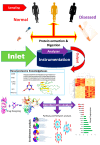Bioinformatics for Renal and Urinary Proteomics: Call for Aggrandization
- PMID: 32024005
- PMCID: PMC7038205
- DOI: 10.3390/ijms21030961
Bioinformatics for Renal and Urinary Proteomics: Call for Aggrandization
Abstract
The clinical sampling of urine is noninvasive and unrestricted, whereby huge volumes can be easily obtained. This makes urine a valuable resource for the diagnoses of diseases. Urinary and renal proteomics have resulted in considerable progress in kidney-based disease diagnosis through biomarker discovery and treatment. This review summarizes the bioinformatics tools available for this area of proteomics and the milestones reached using these tools in clinical research. The scant research publications and the even more limited bioinformatic tool options available for urinary and renal proteomics are highlighted in this review. The need for more attention and input from bioinformaticians is highlighted, so that progressive achievements and releases can be made. With just a handful of existing tools for renal and urinary proteomic research available, this review identifies a gap worth targeting by protein chemists and bioinformaticians. The probable causes for the lack of enthusiasm in this area are also speculated upon in this review. This is the first review that consolidates the bioinformatics applications specifically for renal and urinary proteomics.
Keywords: bioinformatics; databases; omics; renal; tools; urinary proteomics.
Conflict of interest statement
The authors declare no conflict of interest.
Figures



References
-
- Wilkins M.R., Sanchez J.C., Gooley A.A., Appel R.D., Humphery-Smith I., Hochstrasser D.F., Williams K.L. Progress with proteome projects: Why all proteins expressed by a genome should be identified and how to do it. Biotechnol. Genet. Eng. Rev. 1996;13:19–50. doi: 10.1080/02648725.1996.10647923. - DOI - PubMed
-
- Klein J.B., Thongboonkerd V. Overview of Proteomics. Contrib. Nephrol. 2004;141:1–10. - PubMed
Publication types
MeSH terms
Substances
LinkOut - more resources
Full Text Sources
Medical
Miscellaneous

